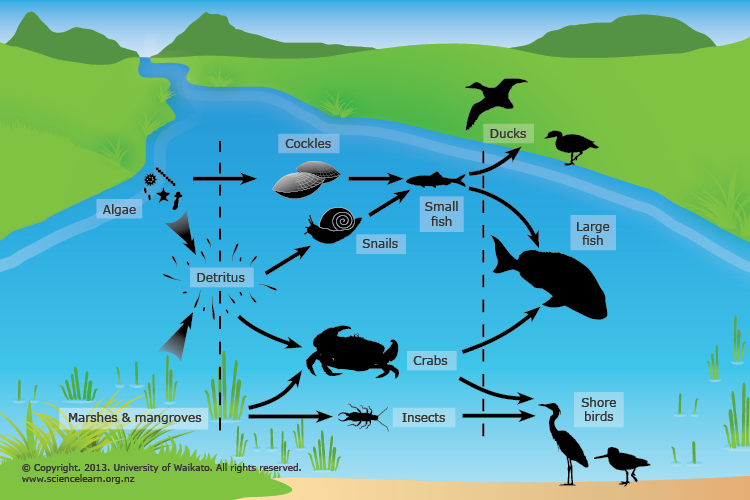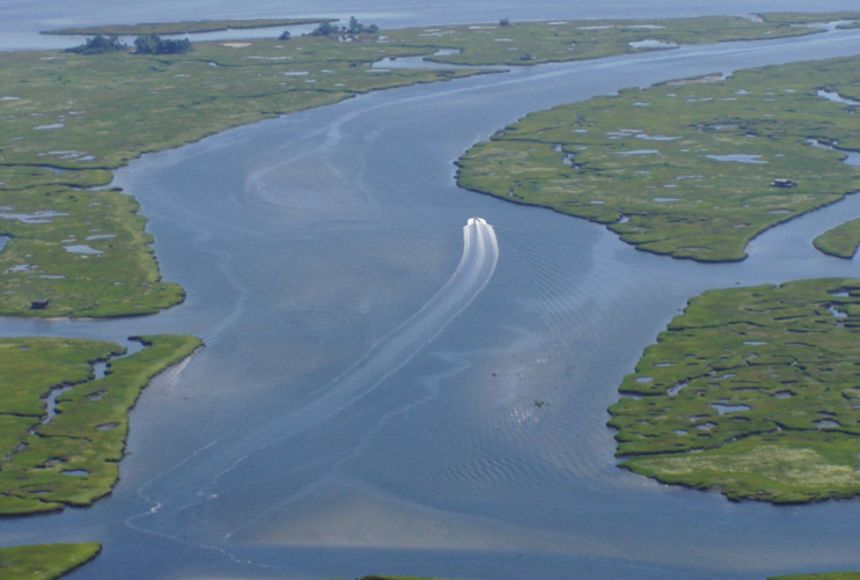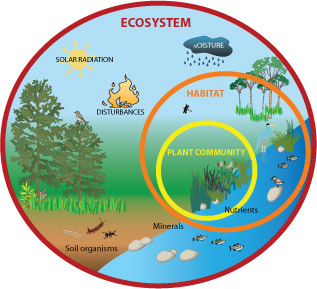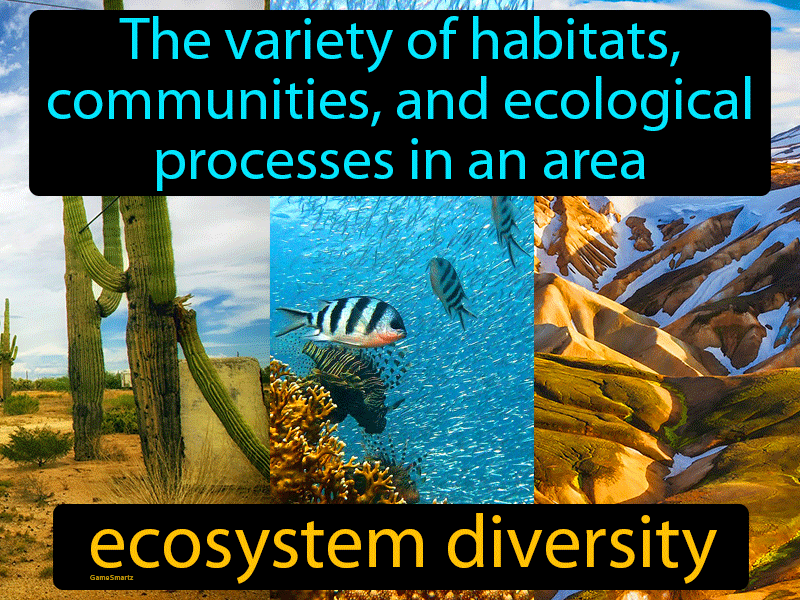Topic what is an estuary ecosystem: Discover the wonders of estuary ecosystems, where rivers meet the sea, creating rich, biodiverse sanctuaries teeming with life and opportunities for exploration.
Table of Content
- What are the characteristics of an estuary ecosystem?
- Definition and Importance of Estuaries
- Physical Characteristics of Estuaries
- Biological Diversity in Estuaries
- Types of Estuaries and Their Formation
- Estuarine Water Circulation and Salinity Patterns
- Ecosystem Services Provided by Estuaries
- YOUTUBE: What is an Estuary in Ecosystem | Environmental Studies
- Threats to Estuarine Ecosystems and Conservation Efforts
- Human Interactions and Impact on Estuaries
- Research and Monitoring of Estuary Health
- Case Studies of Notable Estuaries Around the World
What are the characteristics of an estuary ecosystem?
Estuary ecosystems are unique and diverse habitats that are found where freshwater rivers or streams meet the ocean. They are characterized by a combination of both saltwater and freshwater, creating a dynamic environment that supports a wide range of plant and animal species. Here are some key characteristics of estuary ecosystems:
- Brackish water: Estuaries have a mix of saltwater from the ocean and freshwater from rivers, resulting in brackish water that is less salty than seawater but more salty than freshwater.
- Biodiversity: Estuaries are home to a diverse array of species, including fish, birds, mammals, crustaceans, and plants. They serve as nurseries for many marine organisms and provide important feeding grounds for migratory birds.
- Productivity: Estuaries are highly productive ecosystems, supporting a rich food web. Nutrients from both land and sea contribute to the abundance of life in estuaries.
- Filtering function: Estuaries act as natural filters, trapping sediments and pollutants from rivers and streams before they reach the ocean. This helps to improve water quality and protect marine habitats.
- Transition zone: Estuaries represent a transition zone between terrestrial and marine environments, creating a unique habitat where freshwater and saltwater species coexist.
- Vulnerable to human impacts: Due to their location at the interface of land and sea, estuaries are susceptible to human activities such as pollution, habitat destruction, and overfishing. Conservation efforts are crucial to protect and preserve these valuable ecosystems.
READ MORE:
Definition and Importance of Estuaries
Estuaries, dynamic ecosystems where freshwater from rivers meets the sea, are crucial for both environmental health and human prosperity. These transitional zones blend fresh and saltwater, creating brackish environments rich in biodiversity.
- Biological Significance: Estuaries serve as breeding and nursery grounds for many marine species, supporting a diverse array of life.
- Economic Value: These ecosystems contribute to local economies through fisheries, tourism, and as ports for shipping.
- Environmental Impact: Estuaries play a key role in filtering pollutants from rivers before they reach the ocean, helping maintain water quality.
- Protection Against Erosion: The wetlands and mangrove forests commonly found in estuaries act as buffers, protecting inland areas from storm surges and erosion.
Understanding the intricate balance of estuarine ecosystems is essential for their conservation and the sustainable use of their resources.

Physical Characteristics of Estuaries
Estuaries are unique ecosystems characterized by their physical structure and the dynamic interaction between land and water. These areas, where rivers meet the sea, exhibit a range of distinctive physical features.
- Water Composition: The mixing of freshwater from rivers with salty ocean water creates brackish water, varying in salinity levels.
- Tidal Influence: Estuaries are subject to the ebb and flow of tides, leading to varying water levels and currents which shape the estuarine environment.
- Sedimentation: High levels of sediment are carried by rivers and deposited in estuaries, contributing to rich, fertile mudflats and wetlands.
- Temperature Variability: Estuaries often experience a wide range of temperatures due to the mixing of warm and cold waters and the shallow nature of many estuarine waters.
- Geographical Features: Estuaries can include bays, lagoons, salt marshes, and mangroves, each contributing to the ecosystem"s diversity and productivity.
These characteristics not only define the physical space of estuaries but also influence the biological communities that inhabit these transitional waters.
Biological Diversity in Estuaries
Estuaries boast remarkable biological diversity, acting as a cradle for a multitude of species due to their unique environmental conditions. This diversity is a testament to the adaptability of life forms in varying salinity and water conditions.
- Flora: The estuarine environment supports a variety of plant life, from grasses like Spartina (cordgrass) in salt marshes to mangroves in tropical estuaries. These plants are essential for stabilizing sediments and providing habitats.
- Fauna: Estuaries serve as nurseries for numerous fish and shellfish species, crucial for commercial fisheries. Species such as salmon, herring, and sea trout often start their lives in these protected waters.
- Birdlife: These ecosystems are vital stopover points for migratory birds, offering abundant food and shelter. Species like herons, ospreys, and egrets are common inhabitants.
- Invertebrates: A rich invertebrate community, including crabs, shrimp, and oysters, thrives in estuaries, forming the base of a complex food web that supports a variety of predators.
The interdependence of these diverse biological communities underlines the ecological importance of estuaries, emphasizing the need for their protection and conservation.

Types of Estuaries and Their Formation
Estuaries are categorized based on their geological features and the processes that form them. Understanding these types helps in the conservation and management of these vital ecosystems.
- Coastal Plain Estuaries: Formed by rising sea levels that flood river valleys, these are the most common type of estuaries, characterized by their broad, shallow waters.
- Tectonic Estuaries: Created by tectonic activity, these estuaries form when land subsidence or sea floor uplift shapes a basin that is then filled with water, such as San Francisco Bay.
- Bar-Built Estuaries: These estuaries form when sandbars or barrier islands accumulate along coastlines, trapping water behind them. They are typically shallow and separated from the ocean by a sandbar or barrier island.
- Fjord Estuaries: Carved by glaciers, fjords are deep, narrow estuaries with steep sides or cliffs, created when glaciers retreat and sea water floods the valley.
Each type of estuary plays a crucial role in local ecosystems, supporting diverse communities of plants and animals and providing essential services such as water filtration and flood control.
Estuarine Water Circulation and Salinity Patterns
Estuarine water circulation and salinity patterns are fundamental to the functioning of these ecosystems, influencing both the physical environment and the biological communities.
- Water Circulation: Estuaries exhibit complex water circulation patterns driven by tidal forces, river inflow, and wind. These patterns can vary significantly between estuaries, affecting nutrient distribution, sediment transport, and habitat formation.
- Salinity Gradients: Salinity levels in estuaries form a gradient from freshwater at the river"s mouth to seawater at the estuary"s mouth. This gradient creates a variety of niches, accommodating a diverse range of species adapted to different salinity levels.
- Stratification: In some estuaries, water layers of different salinities may form distinct layers, with denser, saltier water below and fresher water above. This stratification can impact oxygen levels, nutrient cycling, and the distribution of organisms.
- Tidal Mixing: The degree of tidal mixing influences estuarine characteristics. In well-mixed estuaries, salinity is relatively uniform from top to bottom, while in partially mixed estuaries, a pronounced salinity gradient exists between the surface and deeper waters.
- Seasonal Variations: Seasonal changes in river flow and oceanic conditions can lead to significant variations in water circulation and salinity patterns, affecting estuarine ecology throughout the year.
Understanding these dynamics is crucial for the management and conservation of estuarine ecosystems, as they directly affect the health and productivity of these vital habitats.

Ecosystem Services Provided by Estuaries
Estuaries offer a multitude of ecosystem services, underpinning not only ecological balance but also human economies and communities. These critical services highlight the inherent value of estuaries beyond their natural beauty.
- Nursery Grounds: Many fish and shellfish crucial to commercial and recreational fishing industries rely on the sheltered waters of estuaries as nursery grounds.
- Water Filtration: Estuaries filter pollutants and sediments from rivers before they reach the ocean, improving water quality and clarity.
- Carbon Sequestration: Estuarine plants, particularly mangroves and salt marshes, play a significant role in capturing and storing carbon dioxide, helping to mitigate climate change.
- Storm Protection: The natural barrier provided by estuarine wetlands and marshes can reduce the impact of storm surges, protecting inland communities from flooding and erosion.
- Biodiversity Hotspots: The unique blend of fresh and saltwater creates habitats for a diverse array of species, contributing to global biodiversity.
- Economic Benefits: Estuaries contribute to the economy through fisheries, tourism, and harbors, supporting local and national economies.
- Recreational Opportunities: They offer numerous recreational opportunities, from bird watching and hiking to boating and fishing, enhancing community well-being and quality of life.
The preservation and sustainable management of estuarine ecosystems are crucial to maintaining these essential services for future generations.
What is an Estuary in Ecosystem | Environmental Studies
Dive into the mesmerizing world of estuaries in our video, where land and sea meet to create a unique and thriving habitat. Explore the beauty and biodiversity of this dynamic environment like never before!
What is an Estuary
Join us on a journey through the wonders of the ecosystem in our video, where nature\'s intricate balance is on full display. Witness the interconnectivity of plants, animals, and the environment that sustains us all.
Threats to Estuarine Ecosystems and Conservation Efforts
Estuarine ecosystems face numerous threats that can undermine their health and the valuable services they provide. Addressing these threats through conservation efforts is crucial for their sustainability.
- Pollution: Runoff from agriculture, industry, and urban areas can introduce harmful chemicals and excess nutrients, leading to water quality degradation and harmful algal blooms.
- Habitat Destruction: Development along coastlines can lead to the loss of critical habitats such as wetlands, mangroves, and seagrass beds, which are essential for biodiversity and coastal protection.
- Overfishing: Unsustainable fishing practices can deplete fish stocks and disrupt the delicate balance of estuarine food webs.
- Climate Change: Rising sea levels, increased temperatures, and changing precipitation patterns can alter estuarine environments, affecting their structure and function.
- Invasive Species: Non-native species can outcompete native flora and fauna, leading to loss of biodiversity and alteration of ecosystem dynamics.
Conservation efforts include establishing protected areas, restoring degraded habitats, implementing sustainable land use and water quality practices, and conducting research and monitoring to understand estuarine dynamics and threats. Collaboration among governments, communities, and organizations is essential to preserve these vital ecosystems for future generations.

Human Interactions and Impact on Estuaries
Estuaries are dynamic ecosystems that play a crucial role in the environment, economy, and society. Human interactions with estuaries have both positive and negative impacts. By understanding these interactions, we can better appreciate and protect these vital ecosystems.
Positive Impacts
- Conservation and Restoration: Many communities and organizations actively participate in estuary conservation and restoration projects, helping to preserve and enhance estuarine environments for future generations.
- Sustainable Practices: The adoption of sustainable fishing, farming, and aquaculture practices near estuarine areas helps to minimize negative impacts and ensures the long-term health of these ecosystems.
- Education and Research: Estuaries serve as natural laboratories for scientific research and education, fostering a greater understanding of ecological processes and promoting environmental stewardship.
Negative Impacts
- Pollution: Urban, agricultural, and industrial runoff can introduce pollutants into estuaries, affecting water quality and harming aquatic life.
- Habitat Destruction: Development along coastlines can lead to habitat loss for many species that rely on estuaries, including the removal of mangroves, salt marshes, and seagrasses.
- Overfishing: Unsustainable fishing practices can deplete fish stocks, disrupt food webs, and harm the overall biodiversity of estuarine ecosystems.
- Climate Change: Rising sea levels and increased storm frequency associated with climate change pose significant threats to estuarine habitats and the services they provide.
Strategies for Mitigation and Coexistence
- Implementing and enforcing regulations to reduce pollution and manage waste.
- Supporting and expanding protected areas to conserve critical estuarine habitats.
- Promoting community involvement in estuarine conservation through education and outreach.
- Adopting integrated coastal zone management practices that balance development needs with conservation priorities.
By acknowledging the profound impact humans have on estuaries and taking steps to mitigate negative effects, we can ensure the health and resilience of these important ecosystems for generations to come.
Research and Monitoring of Estuary Health
Research and monitoring are integral components of understanding and preserving estuary health. These activities help scientists, policymakers, and communities to gauge the health of estuaries, identify threats, and implement effective management strategies.
Key Research Areas
- Water Quality: Studies focus on parameters such as temperature, salinity, pH, dissolved oxygen, and pollutants to assess the water quality and its impact on estuarine life.
- Habitat Assessment: Research on the extent, condition, and changes in estuarine habitats, including salt marshes, mangroves, and seagrass beds, provides insight into ecosystem health and biodiversity.
- Biological Surveys: Monitoring the populations and health of key species helps in understanding food webs, species diversity, and the impact of human activities on estuarine ecosystems.
- Impact of Climate Change: Research on the effects of climate change, including sea-level rise, temperature changes, and increased storm activity, helps in predicting and mitigating impacts on estuaries.
Monitoring Techniques
- Remote Sensing: Satellite imagery and aerial photography are used to monitor large-scale environmental changes and habitat shifts over time.
- In-Situ Measurements: Direct measurements of water and sediment quality, along with biological sampling, provide detailed local data on estuarine conditions.
- Modeling: Computational models simulate estuarine dynamics and predict future changes based on various environmental and anthropogenic factors.
- Citizen Science: Engaging the public in monitoring efforts, such as water quality testing and species counts, enhances data collection and fosters community involvement in estuary conservation.
The Role of Technology
Advancements in technology, including sensor networks, drones, and machine learning algorithms, have greatly enhanced the efficiency and scope of research and monitoring efforts, enabling real-time data collection and analysis.
Through ongoing research and monitoring, we can better understand the complex interactions within estuarine ecosystems, leading to more informed decision-making and effective conservation strategies that ensure the resilience and health of estuaries worldwide.

READ MORE:
Case Studies of Notable Estuaries Around the World
Estuaries are found across the globe, each with its unique ecological characteristics, challenges, and conservation efforts. Highlighting several notable estuaries provides insight into their importance and the diverse approaches to their management and preservation.
Amazon River Estuary, South America
The Amazon River Estuary is one of the largest in the world, known for its vast biodiversity and significant influence on the global climate. Research in this area focuses on its unique freshwater plume, extensive mangrove forests, and the impact of deforestation and climate change.
Chesapeake Bay, USA
As North America"s largest estuary, Chesapeake Bay has been the focus of extensive restoration efforts to combat pollution, habitat loss, and overfishing. These efforts include pollution control measures, oyster reef restoration, and sustainable fisheries management.
Ganges-Brahmaputra-Meghna Delta, South Asia
This delta, formed by the confluence of three rivers, is crucial for the livelihoods of millions of people. Studies here address sediment transport, wetland conservation, and the impacts of rising sea levels and human settlement on delta dynamics.
Yangtze River Estuary, China
The Yangtze River Estuary is pivotal for its economic, ecological, and cultural significance. Efforts to balance economic development with ecological preservation include habitat restoration projects and the establishment of protected areas for endangered species like the Chinese sturgeon.
Murray-Darling Basin, Australia
This basin hosts a complex network of rivers and estuaries critical to Australia"s water resources. Conservation strategies focus on water resource management, addressing salinity issues, and restoring aquatic and riparian habitats.
These case studies illustrate the global importance of estuaries and the need for tailored, sustainable management practices to protect these vital ecosystems. By learning from these examples, communities worldwide can apply best practices in estuary conservation and restoration.
Estuaries are dynamic ecosystems, crucial for biodiversity and human well-being. Understanding their complexity inspires conservation and sustainable interaction, ensuring their vitality for future generations.










